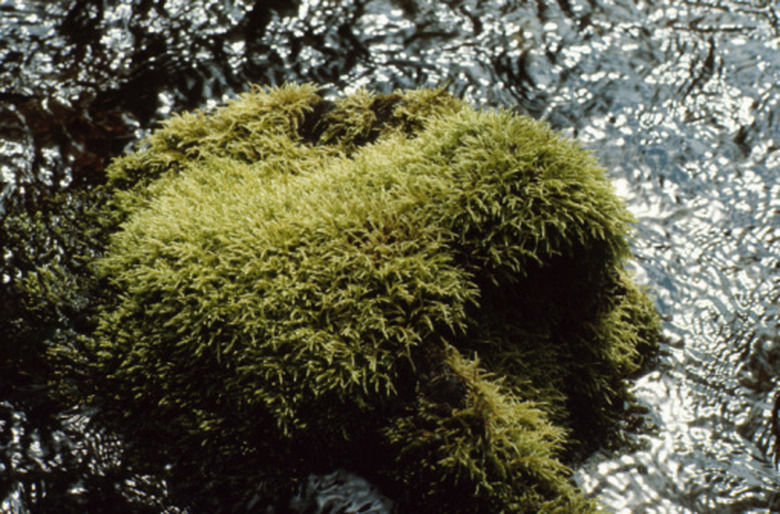Why Does Moss Grow Close To The Ground?
Like all plants, mosses descend from green algae. When waters began receding from land, approximately 450 million years ago, some algae became land plants through adaptations that allowed them to survive without being in water.
Like all plants, mosses descend from green algae. When waters began receding from land, approximately 450 million years ago, some algae became land plants through adaptations that allowed them to survive without being in water. Mosses are third behind flowering plants and ferns in diversity, with more than 10,000 species in 700 genera, according to the University of California Museum of Paleontology. They thrive in many habitats, including the Arctic and tropical rain forests.
Low-Growing
According to Volunteer State Community College, mosses, a member of the plant kingdom's Division Bryophyta, have small, low-growing bodies because they lack a vascular system and have no true roots, stems or leaves. They must absorb water directly from the soil or flowing over them. A plant's vascular system is similar to a human's circulatory system but, in plants, two types of cells form bundles of tissues to transport water and nutrients throughout the plant. The bundles are stiff, which also helps plants grow tall. The lack of bundles to transport water and nutrients limits the height of bryophytes, generally keeping the largest under 8 inches. Mosses also are restricted to living in damp locations.
- Like all plants, mosses descend from green algae.
- The lack of bundles to transport water and nutrients limits the height of bryophytes, generally keeping the largest under 8 inches.
Adaptations
Mosses have different methods for acquiring water and nutrients. Most mosses have very absorptive surfaces, drawing in nutrients from water flowing over them and then passing water and nutrients from cell to cell. Others take nutrients directly from the soil or other substances on which they grow and transfer the nutrients through channels in their tissues to their growing tips. Mosses can also dehydrate for long periods without permanent damage.
Reproduction
As a sign of their relationship to algae, mosses need at least a thin film of water to reproduce because sperm must swim to reach an egg for fertilization. Moss reproduces by spores in alternation of generations. The first generation, the sporophyte generation, makes spores, which produce the plant that looks to us like moss. A bed of moss is the gametophyte phase of the moss life cycle, which produces gametes, which are male sperm cells and female eggs. This stage of reproduction requires water. The plant produces gametes in the antheridia, the male organs, and eggs in the archegonia, the female organs, both located at the tips of moss leaflets. The sperm-making antheridias look like tiny flowers at the moss leaflet's tip. Every sperm has two tails and swims by available water drops to the female egg in an archegonium. The resulting zygote is the start of a new sporophyte stage of the life cycle. The zygote develops within the archegonia and lives as parasite on it for its entire life. Mosses also spread asexually by sending out new shoots in the spring from previous year's growth. If a part of the moss body breaks off, it can also grow a new plant if it lands in an area with adequate moisture.
- Mosses have different methods for acquiring water and nutrients.
- A bed of moss is the gametophyte phase of the moss life cycle, which produces gametes, which are male sperm cells and female eggs.
Moss Importance
Although they may be small, primitive plants, without showy flowers, mosses play important environmental roles. Mosses readily absorb whatever is around them and serve as indicators of pollution and environmental degradation, notes Oregon State University. By forming carpets, mosses also provide erosion prevention as they aid in moisture control and hold soil that otherwise would be wind blown or washed away by water. Mosses also have been used in horticulture because they increase the amount of water soil can store and improves its capacity for holding nutrients.
